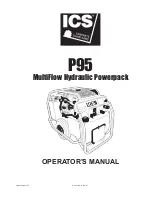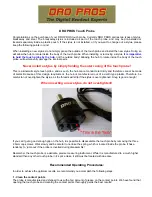
6
7. Instructions for Use
• Always observe the safety instructions and applicable regulations.
• Use only one hand to hold the tool, do not place your other hand over the air vents
• Prior to operation:
• Mount the correct accessory for the application.
• Set the desired air temperature.
7.1 Switching On and Off
• To switch the tool on, set the on/off switch to position I or II. A small amount of smoke may be emitted after switching on; this does
not indicate a problem.
• To switch the tool off, adjust to the lowest temperature to cool off, then set the on/off switch to position 0. Let the tool cool down
before moving or storing it.
7.2 Temperature Setting
• Turn ON/OFF switch to I or II, depending on temperature you need. Increase or decrease the outlet temperature gradually by
turning the adjust knob.
• Turn counter-clock wise to increase, clock wise to decrease the temperature.
7.3 Stripping Paint
• Mount an appropriate accessory.
• Set a high air temperature.
• Switch the tool on.
• Direct the hot air onto the paint to be removed.
• When the paint softens, scrape the paint away using a hand scraper.
a) “Hidden areas such as behind walls, ceilings, floors, soffit boards and other panels may contain flammable materials that could
be ignited by the heat gun when working in these locations. The ignition of these materials may not be readily apparent and
could result in property damage and injury to persons.
When working in these locations, keep the heat gun moving in a back-and-forth motion. Lingering or pausing in one spot could
ignite the panel or the material behind it.”
IMPORTANT SAFETY INSTRUCTIONS.
READ THESE INSTRUCTIONS
WARNING: Extreme care should be taken when stripping paint. The peelings, residue and vapors of paint may contain lead,
which is poisonous. Any pre-1977 paint may contain lead and paint applied to homes prior to 1950 is likely to contain lead.
Once deposited on surfaces, hand to mouth contact can result in the ingestion of lead. Exposure to even low levels of lead can
cause irreversible brain and nervous system damage; young and unborn children are particularly vulnerable.
Before beginning any paint removal process you should determine whether the paint you are removing contains lead. This can
be done by your local health department or by a professional who uses a paint analyzer to check the lead content of the paint
to be removed. LEAD-BASED PAINT SHOULD ONLY BE REMOVED BY A PROFESSIONAL AND SHOULD NOT BE REMOVED
USING A HEAT GUN.



























